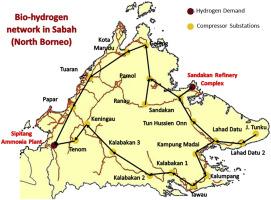International Journal of Hydrogen Energy ( IF 7.2 ) Pub Date : 2020-05-27 , DOI: 10.1016/j.ijhydene.2020.04.179 Chee Hoong Lee , Darren Yu Lun Chong , Sadaf Hemmati , M. Mostafa Elnegihi , Dominic C.Y. Foo , Bing Shen How , ChangKyoo Yoo

|
The shift from conventional hydrogen production that utilised fossil-based energy towards a more sustainable practice is essential. Recently, the interest in utilising renewable hydrogen sources associated with bio-gas has risen. This work aims to develop a P-graph methodology for bio-hydrogen network synthesis, where oil refineries and ammonia plants act as bio-hydrogen sinks, while palm oil mills serve as the bio-hydrogen sources. The latter produces huge amount of palm oil mill effluent (POME) which may be converted to bio-hydrogen. The model is optimised with the aim to minimise the total network cost, whilst fulfilling the demand of all hydrogen sinks. Two case studies in Malaysia are used to illustrate the effectiveness of the proposed model. Results show that the overall network cost can be reduced by 45.6% (first case study) and 85.8% (second case study) when bio-hydrogen is supplied from the abundant POME in the study areas. Besides, the capability of the proposed P-graph framework in conducting uncertainty analysis and technology benchmarking study, are also demonstrated.
中文翻译:

用P图方法从棕榈油厂的废水中合成全国范围内的生物氢网络
从利用基于化石能源的常规氢生产向更具可持续性的实践转变至关重要。最近,对利用与生物气相关的可再生氢源的兴趣上升了。这项工作旨在开发一种用于生物氢网络合成的P线图方法,其中炼油厂和氨厂充当生物氢汇,而棕榈油厂充当生物氢源。后者产生大量的棕榈油厂废水(POME),可将其转化为生物氢。该模型经过优化,旨在最大程度地降低总网络成本,同时满足所有氢汇的需求。在马来西亚进行了两个案例研究,以说明该模型的有效性。结果表明,总体网络成本可以降低45.6%(第一个案例研究)和85。当研究区域中的大量POME提供生物氢时,为8%(第二个案例研究)。此外,还展示了所提出的P-graph框架进行不确定性分析和技术基准研究的能力。



























 京公网安备 11010802027423号
京公网安备 11010802027423号